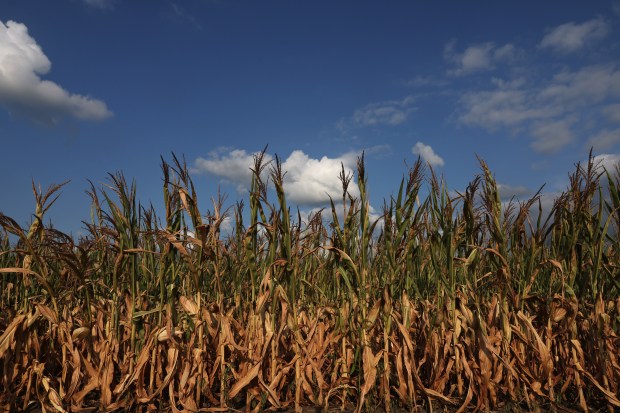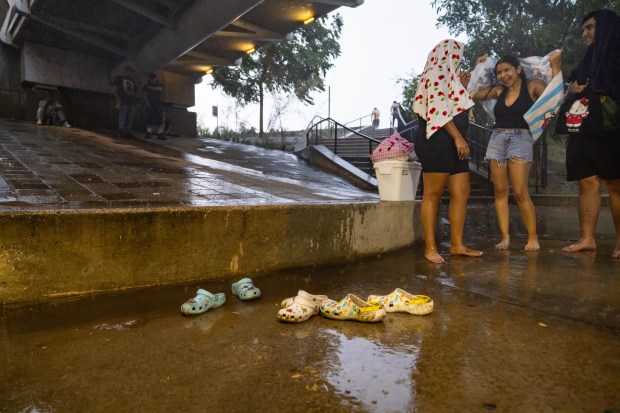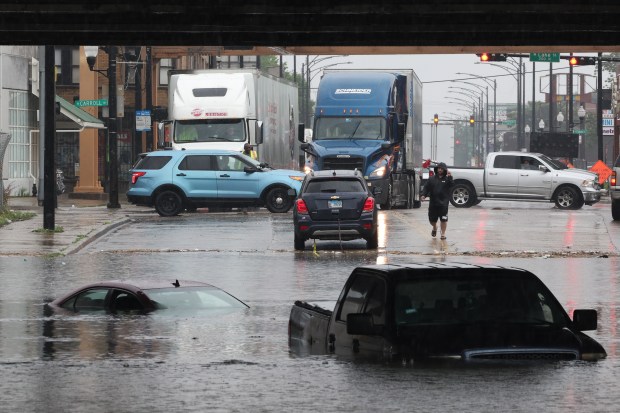Many people were stunned to see the intense flooding and devastation caused by Hurricane Helene in western North Carolina communities, located inland and tucked thousands of feet above sea level in the Blue Ridge Mountains.
Asheville, North Carolina, has long been considered a “haven” from such disasters. So has the Great Lakes region.
“Unfortunately, extreme weather is always such a timely discussion. We’re talking about Helene, but every week it’s something different, every day it’s something different,” said Bernadette Woods Placky, chief meteorologist at the climate science education nonprofit Climate Central. “Weather is the primary way that people experience climate change.”
But the topic of climate change continues to be contentious, especially in the run-up to November’s presidential election.
During Tuesday’s vice presidential debate, Donald Trump’s running mate, Ohio Sen. JD Vance, downplayed the role of fossil fuel emissions in climate change, labeling it “weird science” despite overwhelming scientific consensus that these heat-trapping greenhouse gases are indeed the leading cause.
Today, experts are better equipped than ever to draw connections between climate change from human activities and extreme weather including heatwaves, heavy rainfall, storms and droughts.
Called weather attribution science, researchers have honed and refined their methods for almost two decades using real-world data and models to establish if and how climate change might have influenced the intensity and likelihood of a specific event.
“This is the key idea behind attribution: We look at possible weather in the world we live in today and compare it to possible weather in the world that might have been without climate change,” said Friederike Otto, a climatologist who in 2015 helped launch World Weather Attribution, a collaborative initiative based in Europe and the United Kingdom.
The methodology seeks answers to two crucial questions: Would an extreme weather event have been just as likely to happen now as it was before humans started burning fossil fuels in the late 1800s? Would it have the same intensity in a world without climate change as it would in today’s world, with 2.2 degrees Fahrenheit of global warming caused by greenhouse gas emissions from human activities?
The results are often eye-opening. In many cases, they help dispel misconceptions that a disaster is a one-off rarity or that some areas will be unaffected by the impacts of climate change — places like Asheville and the Midwest.
Even if a certain location were unaffected by direct damages, what happens in vulnerable places can have ripple effects, leading to more widespread power and cellphone service outages, as well as limited access to clean water and food supplies.
“Why we care about climate change and why we do these attribution studies is because climate change affects the lives and livelihoods of people across the world, people in every country, in every city,” Otto said. “It’s not just some people, somewhere else or some time in the future. It is here and now.”
Heavier rains and worse flooding
These studies have found that, across the world, extreme rainfall has become more common and intense due to climate change; there is a high degree of confidence that such is the case in the central part of the United States.
This occurs mainly because a warmer atmosphere can hold more water vapor — for every 1.8-degree Fahrenheit increase in temperature, the atmosphere can hold 7% more moisture. It’s evident in the Midwest, where experts say summers are becoming more humid, leading to severe storms and sticky, dangerous levels of heat.
Between 1895 and 2019, average precipitation in Illinois increased by 15%. Last year, eight of nine weather events that affected Illinois and cost billions of dollars were all severe storms.
More common and intense rainfall has also resulted in more frequent and severe flooding in noncoastal areas — though these events can also be exacerbated by other factors such as land use, infrastructure and water management. A national climate assessment released last year indicated the Midwest has incurred over $49 billion in economic damages due to flooding since 1980.
In urbanized areas like Chicago, the predominance of built-up areas like roads, parking lots and rooftops means water can’t be easily soaked up by soil. Good stormwater infrastructure like drains, gutters and pipes can control the flow of rainfall, but they can also be easily overwhelmed. Such was the case with the area’s Deep Tunnel system during particularly heavy rains in early July 2023.
Weather attribution scientists point out that natural hazards become disasters as a result of social vulnerabilities, in the United States affecting low-income communities of color disproportionately. For instance, where there are more plants and green spaces, these can absorb more of that rain and prevent stormwater runoff and floods. In Chicago, however, a Tribune investigation in 2022 found the city had planted more trees in whiter, wealthier neighborhoods.
More than a year later, some West Side residents are still dealing with the damage from last July’s flooding and paying for expensive repairs. Understanding precipitation patterns is key to improving prediction models and preparing for more intense, frequent rainfall and possible subsequent flooding so those most vulnerable don’t bear the brunt of the impact.
Hurricanes and tornadoes

While the total number of tropical cyclones, including hurricanes, per year hasn’t changed, weather attribution scientists have found that climate change has increased the number of the most intense and destructive tropical storms. This is because of increased atmospheric moisture and more intense rainfall, as well as warming oceans that create more powerful, rapidly intensifying hurricanes that carry more water.
Before Helene made landfall, Woods Placky said, ocean temperatures in the Gulf of Mexico were some 2 degrees hotter than normal — something climate change made 300 to 500 times more likely.
“That’s what helped with the rapid intensification that we saw, and then all of the inland flooding that we saw,” she said.
Heightened storm surges from rising sea levels, combined with reasonable speculation that cyclones are shifting away from the equator because of warming water, means that tropical cyclones might be able to reach locations historically less prepared for them. Even in areas used to hurricanes, quick intensification can significantly shorten reaction periods for emergency preparations.
Some tornadoes come from supercells — strong, rotating thunderstorms — but others can be spawned by hurricanes. In any form, they can be powerful and damaging.
After making landfall in early July, Hurricane Beryl prolifically produced tornadoes all the way north to upstate New York. According to Climate Central, Hurricane Beryl developed and intensified over warm waters. Those unusually warm temperatures were up to 400 times more likely due to human-caused climate change.
Even when tropical storms don’t produce tornadoes inland, they can bring in moisture that fuels more localized storms.
During thunderstorms on July 16, the National Weather Service in Chicago issued 16 tornado warnings, the most they’ve sent out on a single day since 2004. At that point in the year, Illinois had already experienced over 100 tornadoes, though the state typically averages 50 tornadoes annually.
As the air in the Midwest becomes more saturated with humidity, it brews stronger summer thunderstorms that can produce tornadoes. Observations also indicate tornadoes are happening more often during nontraditional tornado months as winters in the region become warmer and, according to new research led by a University of Illinois Chicago scientist, wetter.
Excessive and prolonged heat

Scientists have found that every heat wave in the world is now stronger and likelier to happen because of climate change and a rapidly warming world. “Don’t be too cautious — heatwaves are unilaterally linked to global warming,” reads a World Weather Attribution report.
“That really matters, because heat waves are by far the deadliest extreme events that we know. They, of course, have a huge impact on people that are already very vulnerable,” Otto said. “For example, people living outdoors, homeless people, people in refugee camps and conflict zones, people already living (with) water shortages, but also people that are living among most of us in our daily lives, construction workers, transport drivers, farmers or just elderly people living in poorly insulated homes.”
For instance, the report says a heat wave that would have occurred once in 10 years before humans began burning fossil fuels will now happen 2.8 times over 10 years and be 2.2 degrees hotter. At the current global warming average of 3.6 degrees, it will occur 5.6 times and be 4.68 degrees hotter.
Still, these scientific assertions are globally averaged numbers for moderate heat waves, and extreme heat waves in a specific location can be several hundred times more likely because of climate change, according to the report.
Other research has similarly found that heat waves in the United States have increased in likelihood due to climate change; for instance, a heat wave that hit much of North America in July 2012 was found to have been at least four times more likely over north central states than it would’ve been in preindustrial times.
Heat poses a unique problem for cities like Chicago, where the abundance of skyscrapers and asphalt and the lack of green spaces trap high temperatures, amplifying heat by more than 8 degrees for 1.7 million of almost 2.7 million people. Just over 37,000 people in the city experience the highest index of at least 12 degrees. This urban effect can make stretches of abnormally hot weather particularly dangerous in densely populated cities.
The complexity of drought

Because of the complexity and different forms of drought, scientists have only been able to determine with certainty that these events are becoming more common and severe in certain areas of the world, including the western United States.
Drought happens as a warming atmosphere evaporates moisture from the soil but also as individual rainfall events become heavier in short and intense bursts. This saturates the ground, and waterlogged soil doesn’t absorb additional rain.
Illinois State Climatologist Trent Ford previously told the Tribune that research suggested precipitation variability is increasing with climate change, which means that prolonged, dry periods are now interspersed with intense rainfall that causes flooding. So these intense rains often do little to relieve dry conditions and cause a sort of weather whiplash.
While there is not much scientific certainty yet about how and if drought has become more common and intense in the Midwest, abnormally dry conditions — a step below the official designation of drought — can compound other problems.
And severe drought elsewhere can affect the region in other ways. For instance, water levels in the Lower Mississippi River dipped unusually low for a third year in a row, restricting how much grain can be transported downstream as harvest season gets underway. This has Illinois farmers worried: If levels keep dropping and barge traffic slows navigation, soybean and corn prices could drop too or farmers might not be able to get fertilizer from downstream to prep their fields for next year’s crops.
Climate connections

Because extreme weather knows no borders, its increased likelihood and intensity in one location can have effects elsewhere. For example, climate change worsened the severity of Canadian wildfires in 2023 and made them at least seven times more likely to occur, according to a World Weather Attribution study.
These wildfires blew smoke into the United States as far south as Virginia, causing hazy skies from particulate matter pollution and worsening air quality in some places, including Chicago which earned the title of second most polluted major U.S. city last year.
Weather attribution studies sometimes find that climate change didn’t increase the likelihood or intensity of a given event. But even those findings can inform mitigation efforts; they identify locations that can prepare to be more climate resilient.
“And as we talk about rebuilding, which happens right away after so many of these events,” Woods Placky said, “it’s really critical to have solid information.”
The bottom line, Otto said, is that the burning of fossil fuels is the leading cause of climate change.
“If we don’t stop this,” she added, “of these types of events, most of them would get a lot worse.”




